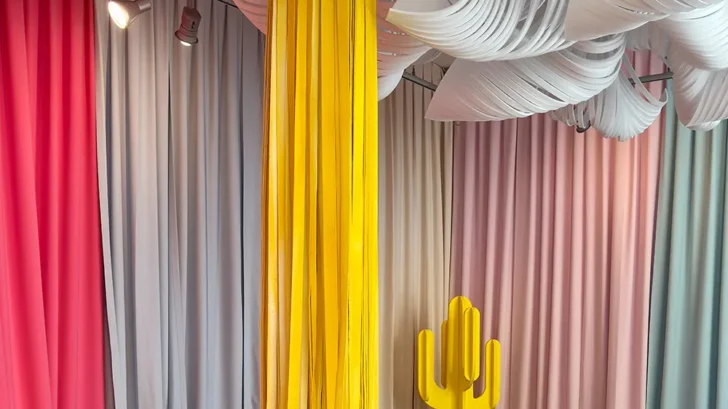
For Salone del Mobile 2025, architect and artist Marie Aigner presents a body of work developed in collaboration with CAMBIO. Under the title LOOKS GOOD. SOUNDS GOOD. FEELS GOOD., the exhibition invites visitors to experience how sound, material, and design can align through recycled resources. The presentation features installations made from leftover denim, all repurposed into modular furniture and acoustic sculptures.
Aigner’s works explore how discarded materials from fashion production can find renewed use through inventive design thinking. Her background in architecture and spatial acoustics informs the collection’s dual focus on function and sensory experience.
Acoustic Innovation Through the Daybed
Among the central works on display, Aigner’s Daybed functions as both a furniture piece and a sound-absorbing element. Composed of CAMBIO’s recycled denim remnants, the Daybed demonstrates how architectural principles can intersect with fashion waste to create pieces that serve multiple roles.
The Daybed’s construction supports comfort while helping manage room acoustics, offering a visual and tactile solution that also performs technically. The piece can be transported and assembled without tools, reflecting a mobile, modular approach to interior design.

The Tatzelwurm as Playful Protest
Aigner also unveils the Tatzelwurm, a sculptural object that references Alpine mythology. She reimagines the folklore creature as a contemporary design element using denim offcuts and PET pellets. The result, a multi-part lounging system, invites play and flexibility. Each segment can function individually as a floor cushion or join to form a larger shape.
Beyond its mythological reference, the Tatzelwurm questions resource disposal habits. By transforming surplus textile into a narrative-rich form, Aigner positions recycling as both necessity and artistic method.

CAMBIO x Marie Aigner Capsule Collection
Beyond the furniture and installations, CAMBIO and Marie Aigner introduce a limited denim capsule, built on the same materials used in the art objects. Designed with GOTS-certified fabrics, the collection emphasizes ease and practicality. Aigner’s architectural sensibility carries through in the silhouettes, which prioritize comfort without compromising structure.
The capsule introduces four core cuts that reflect both comfort and design clarity. Alina features a wide-leg silhouette with pleated detailing for added volume and movement. Odila, a signature CAMBIO style, takes on a distinctive O-shape and includes a flexible stretch waistband. Palazzo Cropped offers a shortened take on the wide-leg fit, while Alma Cropped shares a similar structure but is finished with a drawstring waist for adjustable ease.

Design as a Circular Process
Every piece in the presentation, from the Daybed to the ceiling installation, uses recycled material. Beyond visual design, Aigner focuses on modularity, sound absorption, and zero-tool assembly. These works reject static design in favor of flexible, scalable pieces made for real spaces and everyday use.
This approach aligns CAMBIO and Aigner with broader efforts across design and fashion that prioritize material reuse. Rather than present recycling as an afterthought, they place it at the core of their creative process.

Fashion Meets Architecture
The collaboration stands out by treating fashion remnants not as waste, but as raw material for architectural experimentation. Aigner doesn’t soften the utilitarian look of denim scraps; instead, she builds with them, turning offcuts into walls, seats, and sonic surfaces. CAMBIO’s contribution is equally vital, providing the raw resource and expanding their own identity beyond clothing.
From concept to execution, the installation offers a direct response to material excess. It doesn’t moralize; it creates. Through clear design logic and tactile form, CAMBIO and Aigner show how discarded pieces of fashion can take on entirely new roles within architecture and product design.




